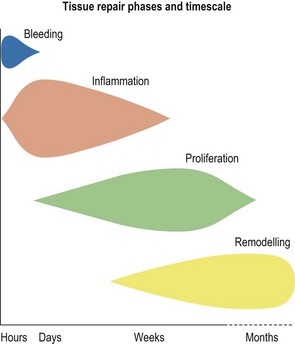Chapter 6 Return to sport
THE INFLAMMATORY PROCESS AND TISSUE HEALING
Remodelling phase
It is during this phase that the collagen matures through the maturation process and the collagen becomes stronger. As the load also increases through the tissue as the athlete returns to training and even playing, the collagen fibres align themselves more appropriately as they should be. The type I collagen that was laid down during the proliferative phase is replaced by type III collagen and the collagen or scar tissue begins to become more like the original tissue (Fig. 6.1).
THE PRINCIPLES OF REHABILITATION
A successful rehabilitation programme needs to address some key areas:
1. The programme must be devised with the healing of the tissue in mind so that a sound physiological basis for starting each different exercise is present and they can be integrated into the programme
2. The specific strengthening requirements to rehabilitate or protect the injured tissue, bearing in mind the physical demands of the activity or sport
3. Other factors such as proprioception which play a vital role for the injured tissue
4. Other associated areas which require attention to prevent the recurrence of the injury, such as core or proximal stability
5. Sport-specific aspects for the athlete, such as tackling in rugby players or the serve in tennis players, etc.
6. Discussions with technical and conditioning staff are required to ensure that overload does not occur and that the athlete will be fully prepared for when they are reintegrated into their normal training regimes
7. A plan for the gradual reintegration into full training and playing is required to ensure that the athlete does not break down as they return to the increased intensity of training and playing
8. A maintenance programme. Once athletes have returned to full training and playing, they often neglect the exercises and preventative work that had rehabilitated them. It is important that they maintain their fitness status by continuing with a maintenance programme to help protect them from recurrence.
Goal setting
• Goals should be specific to the individual and relevant to their performance. For example there is no point giving a sprinter a set time to achieve for running 800 m if they do not normally train in that way.
• Giving the athlete exercises that can have a measured outcome is an excellent way to monitor progress and show the athlete that they are improving. It also gives a marker as to when that specific goal has been achieved so that the athlete can move onto the next one.
• It is important that the goals are realistic to the individual athlete. It will become disheartening if they are unable to achieve any of their objectives and are not able to move along through their rehabilitation programme.
• In a similar way to the achievable section above, there is no point asking an athlete to set a personal best or world record while they are initially recovering from an injury.
• The athlete and each goal need to have a timeframe to work to. This will give targets that the athlete can aim for, but it can also map out the whole rehabilitation process and give the athlete ‘the light at the end of the tunnel’.
Stay updated, free articles. Join our Telegram channel

Full access? Get Clinical Tree





